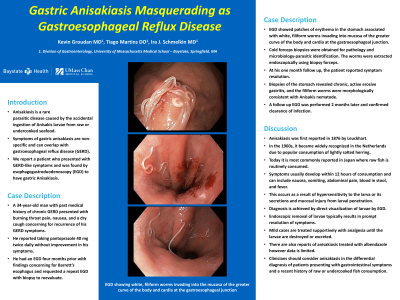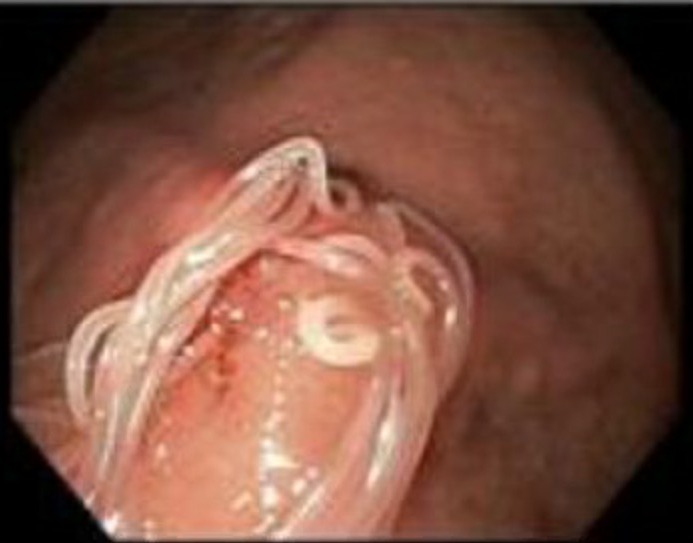Back


Poster Session B - Monday Morning
Category: Stomach
B0735 - Gastric Anisakiasis Masquerading as Gastroesophageal Reflux Disease
Monday, October 24, 2022
10:00 AM – 12:00 PM ET
Location: Crown Ballroom

Has Audio
.jpg)
Kevin Groudan, MD
University of Massachusetts Medical School - Baystate
Springfield, MA
Presenting Author(s)
Kevin Groudan, MD, Tiago Martins, DO, Ira Schmelkin, MD
University of Massachusetts Medical School - Baystate, Springfield, MA
Introduction: Anisakiasis is a rare parasitic disease caused by the accidental ingestion of Anisakis larvae from raw or undercooked seafood. Symptoms of gastric anisakiasis are non-specific and can mimic gastroesophageal reflux disease (GERD). We report a patient who presented with GERD-like symptoms and was found by esophagogastroduodenoscopy (EGD) to have gastric anisakiasis.
Case Description/Methods: A 34-year-old man with past medical history of chronic GERD presented with burning throat pain, nausea, and a dry cough concerning for recurrence of his GERD symptoms. He reported taking pantoprazole 40 mg twice daily without improvement in his symptoms. He had an EGD four months prior with findings concerning for Barrett’s esophagus and requested a repeat EGD to reevaluate.
EGD showed patches of erythema in the stomach associated with white, filiform worms invading into mucosa of the greater curve of the body and cardia at the gastroesophageal junction. Cold forceps biopsies were obtained for pathology and microbiology-parasitic identification. The worms were extracted endoscopically using biopsy forceps.
At his one month follow up, the patient reported symptom resolution. Biopsies of the stomach revealed chronic, active erosive gastritis, and the filiform worms were reported to be morphologically consistent with Anisakis nematode. A follow up EGD was scheduled in two months to ensure clearance of infection.
Discussion: Anisakiasis was first reported in 1876 by Leuckhart. In the 1960s, it became widely recognized in the Netherlands due to popular consumption of lightly salted herring. Today, it is most commonly reported in Japan where raw fish is routinely consumed. Symptoms usually develop within 12 hours of consumption and can include nausea, vomiting, abdominal pain, blood in stool, and fever. This occurs as a result of hypersensitivity to the larva or its secretions and mucosal injury from larval penetration. Diagnosis is achieved by direct visualization of larvae by EGD. Gastric mucosal edema surrounding the zone of larval penetration is often found. Endoscopic removal of larvae typically results in prompt resolution of symptoms. Some mild cases are treated supportively with analgesia until the larvae are destroyed or excreted. There are also reports of anisakiasis treated with albendazole however data is limited. Clinicians should consider anisakiasis in the differential diagnosis of patients presenting with gastrointestinal symptoms and recent consumption of raw or undercooked fish.

Disclosures:
Kevin Groudan, MD, Tiago Martins, DO, Ira Schmelkin, MD. B0735 - Gastric Anisakiasis Masquerading as Gastroesophageal Reflux Disease, ACG 2022 Annual Scientific Meeting Abstracts. Charlotte, NC: American College of Gastroenterology.
University of Massachusetts Medical School - Baystate, Springfield, MA
Introduction: Anisakiasis is a rare parasitic disease caused by the accidental ingestion of Anisakis larvae from raw or undercooked seafood. Symptoms of gastric anisakiasis are non-specific and can mimic gastroesophageal reflux disease (GERD). We report a patient who presented with GERD-like symptoms and was found by esophagogastroduodenoscopy (EGD) to have gastric anisakiasis.
Case Description/Methods: A 34-year-old man with past medical history of chronic GERD presented with burning throat pain, nausea, and a dry cough concerning for recurrence of his GERD symptoms. He reported taking pantoprazole 40 mg twice daily without improvement in his symptoms. He had an EGD four months prior with findings concerning for Barrett’s esophagus and requested a repeat EGD to reevaluate.
EGD showed patches of erythema in the stomach associated with white, filiform worms invading into mucosa of the greater curve of the body and cardia at the gastroesophageal junction. Cold forceps biopsies were obtained for pathology and microbiology-parasitic identification. The worms were extracted endoscopically using biopsy forceps.
At his one month follow up, the patient reported symptom resolution. Biopsies of the stomach revealed chronic, active erosive gastritis, and the filiform worms were reported to be morphologically consistent with Anisakis nematode. A follow up EGD was scheduled in two months to ensure clearance of infection.
Discussion: Anisakiasis was first reported in 1876 by Leuckhart. In the 1960s, it became widely recognized in the Netherlands due to popular consumption of lightly salted herring. Today, it is most commonly reported in Japan where raw fish is routinely consumed. Symptoms usually develop within 12 hours of consumption and can include nausea, vomiting, abdominal pain, blood in stool, and fever. This occurs as a result of hypersensitivity to the larva or its secretions and mucosal injury from larval penetration. Diagnosis is achieved by direct visualization of larvae by EGD. Gastric mucosal edema surrounding the zone of larval penetration is often found. Endoscopic removal of larvae typically results in prompt resolution of symptoms. Some mild cases are treated supportively with analgesia until the larvae are destroyed or excreted. There are also reports of anisakiasis treated with albendazole however data is limited. Clinicians should consider anisakiasis in the differential diagnosis of patients presenting with gastrointestinal symptoms and recent consumption of raw or undercooked fish.

Figure: Esophagogastroduodenoscopy revealed white, filiform worms invading into mucosa of the greater curve of the body and cardia at the gastroesophageal junction
Disclosures:
Kevin Groudan indicated no relevant financial relationships.
Tiago Martins indicated no relevant financial relationships.
Ira Schmelkin indicated no relevant financial relationships.
Kevin Groudan, MD, Tiago Martins, DO, Ira Schmelkin, MD. B0735 - Gastric Anisakiasis Masquerading as Gastroesophageal Reflux Disease, ACG 2022 Annual Scientific Meeting Abstracts. Charlotte, NC: American College of Gastroenterology.
